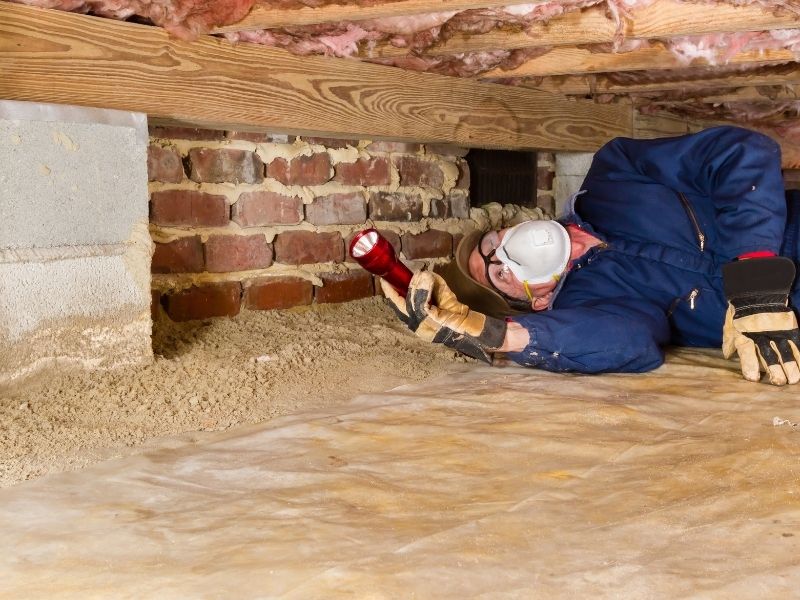Though they are not the type of places to get visitors often, crawl spaces are a part of most houses. Even today, in modern-styled houses where space is too tight for a full-fledged basement, a couple of feet of space below the ground floor is considered sufficient for storage purposes. Other than solving the obvious problem of storage, these crawl spaces are also used for HVAC systems, pipelines, and electric connections.
Now it’s already established that these foundations are not treated like living rooms, but it’s still essential to have them properly ventilated for numerous reasons. A crawl space that is not given proper ventilation can become the cradle of mold, pests, and insects. Not only will this result in a potentially expensive house repair, but it can also affect the health of your loved ones. So, what are some of the options you have to ensure your crawl space gets a bit of air passed through every now and then?

A crawl space can be ventilated in several ways. Here are the best of them:
1. Use an Exhaust Fan
Taking the moisture out of the crawl space is a great idea, and an exhaust fan is a reliable candidate for this job. Consider installing a couple of exhaust fans in the surrounding walls of the crawl space. The IRC (International Residential Code) approves this approach, and generally speaking, exhaust fans neither cost a leg nor require much maintenance either. So, you’ll be opting for a safe, inexpensive, and effective way of ventilating your crawl space.
2. Use a Dehumidifier
As the name suggests, dehumidifiers are capable of eliminating humidity from damp indoor spaces. Having a dehumidifier installed in the foundation will guarantee a moisture-free atmosphere. Top that off with some vapor barriers and you’ll have pretty much nothing to worry about. However, note that a proper energy-saving dehumidifier may cost you a good amount, but you’ll be making a safe investment for sure.
3. Use the HVAC System
Though having an HVAC system in the crawl space is not recommended, it will pose no threat to the area if it is maintained properly. You can use the HVAC system to your advantage by having some air blown into the crawl space. However, bear in mind that this single step is not effective enough to singlehandedly suppress moisture from building up. It can only complement the above-stated approaches.
4. Encapsulation
Encapsulation is a great way to defeat moisture rising from the earth. A plastic sheet will be used to seal the ground of the crawl space and all the surrounding openings. Encapsulation sheets are thicker than vapor barriers and can stop moisture from rising up into the house. Usually, encapsulation is used for sealed crawl spaces where the chances of moisture rising from the surface are high.
All of the above-mentioned methods are part of the IRC’s prescriptions. The IRC (International Residential Code) is a set of rules that makes a house safe for its residents. Complying with the IRC’s requirements is the gateway to ensuring your house follows the general best practices. Note that if the IRC’s prescriptions do not match with your local residential codes, then choose the latter over the former. Since different localities have different codes according to the climate and area, it’s best to stick with the local guide. However, IRC’s requirements are generally followed and that’s why they are to be kept in mind here.
What about Vents?
Now, does the IRC recommend the installation of vents? The answer is yes, they do. According to section R408.1, a vent of 1 square foot is needed for every 150 square feet of crawl space area. Now, for instance, your crawl space area is about 500 square feet. In this situation, 3-4 vents of 1 square foot would get the job done. Furthermore, every corner of the structure must have at least one vent to ensure proper airflow. The IRC also states the acceptable material for these vents which can be read here. Coming to the main question, is venting alone sufficient in making a crawl space resistant to mold and fungi growing? Or are there other steps to keep crawlspaces neat and clean?
Should You Go for a Vented or a Sealed Crawl Space?
The method of ventilating crawl spaces is by far the oldest solution of keeping peace in the foundation but not exactly the most accepted approach today. In the 20th century, researchers concluded that vents are the ideal solution to keep crawl spaces free from moisture. It wasn’t until the last few decades when studies claimed that venting crawl spaces only makes things worse and sealed crawl spaces are better. Since these differences of opinions arose, most building codes adopted the best of both worlds and gave builders a guide to safely ventilate their crawl spaces with and without vents. Basically, it’s up to the builder to make the end decision.
So, should you vent or not? Well, this is a question that would be best answered by the homeowner themselves. Both methods have their own pros and cons. Generally speaking, you should go for a vented crawl space if you’re on a tight budget, but if you can afford to seal off the area and condition it, then sealing is more effective. Nonetheless, there are ways to balance both of these approaches which we will discuss later on. For now, here is a brief insight into the working of vented and sealed crawl spaces.
Comparing Sealed and Vented Crawl Spaces
Although it won’t cost you much to have vents installed, that’s not the only cost to take into account. During winters, the house will obviously be freezing and the cold will creep in through the opening unless you have proper insulation installed. In many such cases, homeowners have to compromise on their utility bills to keep their homes warm. This is why a notable fraction of them prefer their crawlspaces to be artificially conditioned with no vent openings. So, unless you have insulation to back you up, reconsider your decision of having vents in the crawlspace.
As far as the sealed approach is concerned, the IRC does support it. There’s an entire section of provisions dedicated to crawl spaces with no vents in the IRC. In this section, instructions are given to ensure the artificial means are able to get the job done. The code also requires that the entire crawl space must be sealed with the help of a vapor retarder material. This procedure is becoming quite popular and is known as encapsulation. Vapor retarder sheets are spread throughout the area to suppress the chances of vapor spreading and wreaking havoc. Moreover, you’ll need an appliance to keep the crawl space dry. Depending upon the conditioning appliance, the sealed method may cost you a lot.
So, you have both options to choose from. You can either ventilate your crawl space for natural airflow or go for artificial means. If you find yourself stuck between both choices, consider the option in between, which is to open/close vents according to the season and weather. You can do this either by automatic louvers or manually by stuffing foam or insulation in the vent openings to prevent airflow during winter. When the weather warms down a bit, unblock the vents and let the crawl space breathe fresh air.
Why You Should Ventilate Your Crawl Space
Until now we have discussed some of the most useful ways to keep moisture out of crawl spaces. What remains unaddressed is the in-depth importance of ventilating these areas. We all know the basics that poor air quality in the crawl space can lead to the rise of insects, mold, fungi, etc. However, the problem is a lot more complex. The air that is in your crawl space rises up to the structure, this is what we know as the stack effect. To put it straight, a great fraction of the air you breathe in your home consists of the crawl space air, so it’s necessary to cleanse it.
Moisture will always find its way into the crawl space from one way or the other unless you have taken serious measures to resist it. The very earth beneath the house is moist, and it will emit its moisture to the surface. So, your loved ones are at great risk by breathing bad quality air because of a moist crawl space. Other than that, a moist environment is loved by our little soil friends. In no time a swarm of pests will be in the crawl space chewing upon the wooden frames of your small basement. Combine all of these threats together and you’ll be paying a great sum of money for house repairs within a year or two of building it.
Breathing in an atmosphere where mold and mildew thrive can lead to serious respiratory problems in the future, especially for children. The installation of vents, unfortunately, is not enough to tackle the issue. As a matter of fact, vents have been proven as a common reason for the growth of pests in crawl spaces. You’re leaving an open space at the bottom of your house, there are no chances of not having visits from insects and vermin.
The Role of Insulation and Vapor Barriers
Insulation is highly recommended especially if you have a crawl space with vent openings. It will act as a barrier between you and the crawl space from where airflow would come into your house eventually resulting in skyrocketing utility bills and a freezing floor. However, if we’re talking about sealed crawlspaces, the walls of the crawl space being insulated should be enough. It is essential to ensure that the insulation is moisture-resistant. For this purpose, the vapor barriers jump into the frame. They are extremely important because most crawl spaces have pipelines in them and water can leak onto the insulation.
Furthermore, the crawl space can trap cold in winter and when the warm breeze of spring knocks, condensation may occur. When taking measures to keep crawl spaces dry, it’s necessary to eliminate any chances of moisture or cold air creeping into the foundation from the structure above. Old pipes are one of the top reasons behind moisture building up below. Wetness will not only result in the growth of pests, mold, and fungi, but it will also ruin your insulation in no time. Therefore, properly examining the place and sealing off leaks is an absolute must before insulation is installed.
Take Precautionary Measures
Prevention is always better than cure. Here are a few important precautionary measures that will keep your crawl space neat and clean:
Have your crawl space inspected
Having a professional over to check the crawl space at least once every year is a great way to keep things running smoothly in the foundation of your house. This will alert you of a problem before it even rises and save you from costly repairs.
Waterproof the area
Before installing insulation in particular, it is essential to get repairs done around the crawl space, especially for pipes. Old pipes can catch rust and make a mess in the place with even a miniature leakage.
Maintain the HVAC system
The HVAC system is often ignored when the topic of ventilating crawl spaces is discussed. If you have the system in your crawl space, change its filters at their due time and clean the system properly.
Conclusion
Crawl spaces can bring just as much harm as they bring benefits. If not given the attention needed, you’ll end up compromising not just the health of your house, but also of your loved ones. We have given you an in-detail guide on how you can keep the foundation of your house properly ventilated. Adhering to these guidelines will surely keep your crawl space fresh throughout the year.

